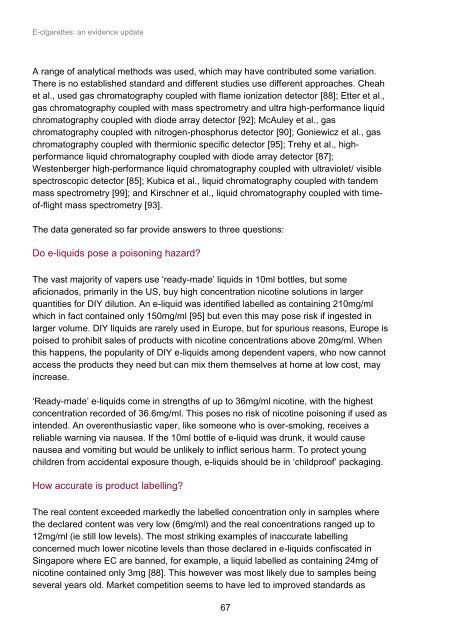E-cigarettes an evidence update A report commissioned by Public Health England
3nOaxpIe4
3nOaxpIe4
You also want an ePaper? Increase the reach of your titles
YUMPU automatically turns print PDFs into web optimized ePapers that Google loves.
E-<strong>cigarettes</strong>: <strong>an</strong> <strong>evidence</strong> <strong>update</strong>A r<strong>an</strong>ge of <strong>an</strong>alytical methods was used, which may have contributed some variation.There is no established st<strong>an</strong>dard <strong>an</strong>d different studies use different approaches. Cheahet al., used gas chromatography coupled with flame ionization detector [88]; Etter et al.,gas chromatography coupled with mass spectrometry <strong>an</strong>d ultra high-perform<strong>an</strong>ce liquidchromatography coupled with diode array detector [92]; McAuley et al., gaschromatography coupled with nitrogen-phosphorus detector [90]; Goniewicz et al., gaschromatography coupled with thermionic specific detector [95]; Trehy et al., highperform<strong>an</strong>celiquid chromatography coupled with diode array detector [87];Westenberger high-perform<strong>an</strong>ce liquid chromatography coupled with ultraviolet/ visiblespectroscopic detector [85]; Kubica et al., liquid chromatography coupled with t<strong>an</strong>demmass spectrometry [99]; <strong>an</strong>d Kirschner et al., liquid chromatography coupled with timeof-flightmass spectrometry [93].The data generated so far provide <strong>an</strong>swers to three questions:Do e-liquids pose a poisoning hazard?The vast majority of vapers use ‘ready-made’ liquids in 10ml bottles, but someaficionados, primarily in the US, buy high concentration nicotine solutions in largerqu<strong>an</strong>tities for DIY dilution. An e-liquid was identified labelled as containing 210mg/mlwhich in fact contained only 150mg/ml [95] but even this may pose risk if ingested inlarger volume. DIY liquids are rarely used in Europe, but for spurious reasons, Europe ispoised to prohibit sales of products with nicotine concentrations above 20mg/ml. Whenthis happens, the popularity of DIY e-liquids among dependent vapers, who now c<strong>an</strong>notaccess the products they need but c<strong>an</strong> mix them themselves at home at low cost, mayincrease.‘Ready-made’ e-liquids come in strengths of up to 36mg/ml nicotine, with the highestconcentration recorded of 36.6mg/ml. This poses no risk of nicotine poisoning if used asintended. An overenthusiastic vaper, like someone who is over-smoking, receives areliable warning via nausea. If the 10ml bottle of e-liquid was drunk, it would causenausea <strong>an</strong>d vomiting but would be unlikely to inflict serious harm. To protect youngchildren from accidental exposure though, e-liquids should be in ‘childproof’ packaging.How accurate is product labelling?The real content exceeded markedly the labelled concentration only in samples wherethe declared content was very low (6mg/ml) <strong>an</strong>d the real concentrations r<strong>an</strong>ged up to12mg/ml (ie still low levels). The most striking examples of inaccurate labellingconcerned much lower nicotine levels th<strong>an</strong> those declared in e-liquids confiscated inSingapore where EC are b<strong>an</strong>ned, for example, a liquid labelled as containing 24mg ofnicotine contained only 3mg [88]. This however was most likely due to samples beingseveral years old. Market competition seems to have led to improved st<strong>an</strong>dards as67


